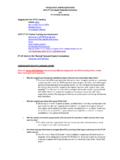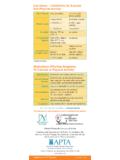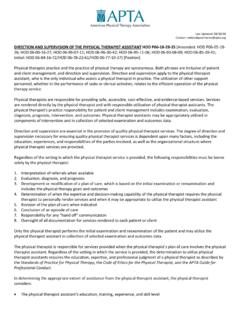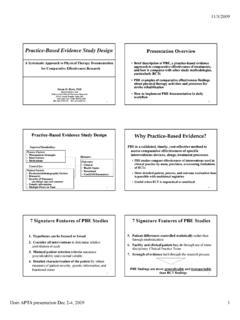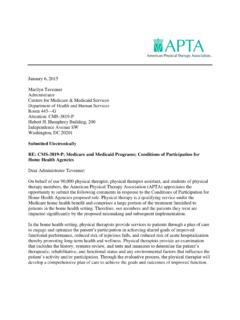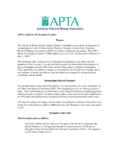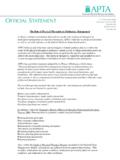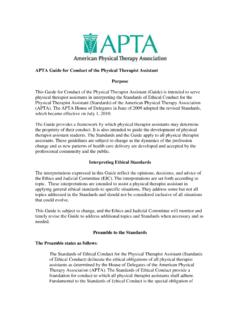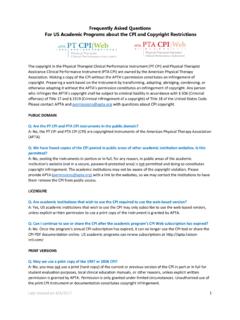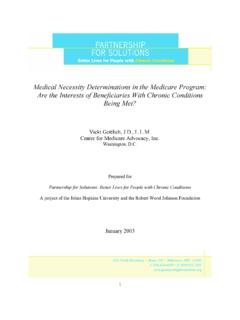Transcription of September 25, 2017 Centers for Medicare and Medicaid ...
1 1 September 25, 2017 Seema Verma, MPH Administrator Centers for Medicare and Medicaid Services Department of Health and Human Services Room 445-G Attn: CMS-1672-P Hubert Humphrey Building 200 Independence Ave, SW Washington, DC 20201 Submitted electronically RE: Medicare and Medicaid Programs; CY 2018 Home Health Prospective Payment System Rate Update and Proposed CY 2019 Case-Mix Adjustment Methodology Refinements; Home Health Value-Based Purchasing Model; and Home Health Quality Reporting Requirements (CMS-1672-P) Dear Administrator Verma: On behalf of our more than 100,000 member physical therapists, physical therapist assistants, and students of physical therapy, the American Physical Therapy Association ( apta ) submits the following comments regarding the Centers for Medicare and Medicaid Services (CMS) Calendar Year (CY) 2018 Home Health Prospective Payment System Rate Update and Proposed CY 2019 Case-Mix Adjustment Methodology Refinements proposed rule.
2 apta s goal is to foster advancements in physical therapist practice, research, and education. The mission of apta is to further the profession s role in the prevention, diagnosis, and treatment of movement dysfunctions and the enhancement of the physical health and functional abilities of members of the public. Physical therapy is an integral service provided to patients in the home health setting. While apta appreciates the overall intent of the CMS proposals, we are very concerned that the Home Health Groupings Model (HHGM), as currently proposed, is being implemented too soon, with significant flaws, and without adequate protections for Medicare beneficiaries . We are most concerned that high-risk beneficiaries those with substantial physical therapy needs may not receive the level and frequency of physical therapy services needed, given the potential economic incentives inherent in this revised case-mix methodology to provide less care for these beneficiaries .
3 The HHGM incentivizes providers to maneuver patients into the most financially beneficial clinical grouping or inappropriately decrease the length of stay. Implementation of the 2 HHGM also will lead to providers avoiding certain types of patients for financial or other considerations, likely resulting in those patients being steered into higher-acuity settings. It is imperative for CMS to ensure that its approach to modify home health payments enhances the delivery of high- quality, timely, cost-effective care to home health patients, including higher-complexity home health agency (HHA) patients who require substantial resources. Given that the HHGM may perpetuate certain complications of the home health prospective payment system (PPS) while also creating new access barriers, we recommend that CMS not advance implementation of the HHGM without first engaging in an extensive discussion with the home health industry to understand the full implications of the HHGM on patient care.
4 apta s Concerns and Recommendations 1. apta encourages CMS not to eliminate the rural add-on payment beginning in 2018. Without the add-on payment, HHAs will be unable to adequately serve Medicare beneficiaries in rural areas. 2. apta supports the CMS proposals to modify the Home Health Quality Reporting Program (QRP) and Value-Based Purchasing (VBP) program. We encourage CMS to include additional patient outcome measures in the VBP program in the future. 3. apta supports the overarching strategies outlined in the Office of the Assistant Secretary for Planning and Evaluation (ASPE) report regarding social risk factors. We also support the testing of social risk factor adjustment models and the reporting of stratified outcomes measures to providers to enable them to better understand the effects of social risk factors on their performance. 4. apta disagrees with implementing the HHGM in a non-budget neutral manner and does not believe CMS has the authority to make such significant adjustments to the PPS.
5 apta strongly urges CMS to implement the HHGM in a budget-neutral manner. 5. apta disagrees with proposed implementation of the HHGM in CY 2019. The HHGM is far more complex than the current PPS without any evidence that it would improve care. apta recommends that the agency not implement the HHGM until it has made significant alterations and improvements to the model. 6. apta has major concerns that the proposed methodology undervalues the important role of rehabilitation and creates perverse financial incentives to deliver less than appropriate care. 7. apta strongly recommends that CMS use several diagnoses, in addition to the principal diagnosis, to categorize an episode into a clinical grouping, as a single diagnosis does not provide sufficient basis for assigning a clinical grouping, nor will it help to align payment with patient characteristics that would benefit from therapy.
6 3 8. apta strongly recommends that CMS expand the list of comorbidity subcategories to better capture diagnoses that cause higher resource utilization. We respectfully request that you consider our more detailed comments and recommendations provided below. CY 2018 Payment Updates For CY 2018, CMS proposes to reduce home health payments by or $80 million. This payment update is based on a 1% payment increase required under the Medicare Access and CHIP Reauthorization Act of 2015 (MACRA), a pre-floor, pre-reclassified hospital wage index, and the discontinuation of rural add-on payments to designated HHAs in rural areas. While apta supports CMS efforts to review home health payments on an annual basis and streamline the payments across the Medicare program, we have concerns that these payment reductions could create barriers to patients access to care, particularly in rural areas.
7 Sunset of Rural Add-On Payment apta has concerns that the expiration of the rural add-on provision of 3% from MACRA will further restrict HHAs from adequately serving Medicare beneficiaries in rural areas. HHAs in these areas already face geographical and financial obstacles to supplying sufficient care to meet the needs of their Medicare population. Discontinuing the rural add-on payment will likely prohibit these agencies from furnishing care to patients with the most critical clinical conditions. Thus, apta urges CMS to develop a policy to support improved access to home care in rural areas prior to the elimination rural add-on payments to HHAs. Such policy would ensure that Medicare beneficiaries have access to integral services, including physical therapy. apta also recommends that CMS explore policies that provide Medicare coverage for services from therapy providers who furnish telehealth services to their patients.
8 Proper application of telehealth rehabilitation therapy services, particularly in underserved areas, potentially can have a dramatic impact on improving care, diminishing negative consequences, and reducing costs. Particularly with the vulnerable home health population, telehealth services may prevent unnecessary hospitalizations or further health complications that may result from restricted access to care. Prior to reinstatement of the rural add-on payment in 2010, HHAs in rural areas reported that they were unable to deliver services in remote areas, due to financial constraints. We fear that rural agencies will face similar outcomes if CMS allows add-on payments in CY 2018 to expire without providing an extension of this policy through its authority. Further, apta has concerns that the elimination of rural add-on payments would lead to workforce shortages in rural areas, as agencies would be forced to reduce wages or eliminate positions altogether.
9 Such shortages in these areas will lead to further restricted access to care for Medicare beneficiaries living in remote areas. Specifically regarding physical therapy services, rural HHAs may not be able to afford to employ physical therapists, further reducing the breadth of services the agencies can furnish and, in turn, decreasing their potential reimbursement rates. We foresee smaller agencies being forced to either drastically reduce essential staff such as physical therapists or close their doors as a result of this proposed policy change. 4 We strongly urge CMS to take action and extend the rural add-on payment under its authority until the agency has put in place alternative safeguards to ensure Medicare beneficiaries continued access to care regardless of their geographical location. Home Health VBP Program CMS is proposing 2 changes to the home health VBP program for CY 2018.
10 First, CMS proposes to increase the Home Health Consumer Assessment of Healthcare Providers and Systems ( HHCAHPS) minimum of completed surveys from 20 to 40. Second, CMS proposes to remove 1 Outcome and Assessment Information Set (OASIS)-based measure in performance year 3 of the program Drug Education on All Medications Provided to Patient/Caregiver during All Episodes of Care because many providers have achieved full performance on this measure. apta supports both of these changes. CMS also suggests several possible measure areas for future years of the home health VBP including: total change in activities of daily living (ADL)/IADL performance by HHA patients, composite functional decline measure, and behavioral health measures. apta supports the development of future measures in these areas for the home health VBP program. Home Health QRP The Improving Medicare Post-Acute Care Transformation Act of 2014 (IMPACT Act) requires the implementation of new data-reporting requirements for certain post-acute care providers, including HHAs.
